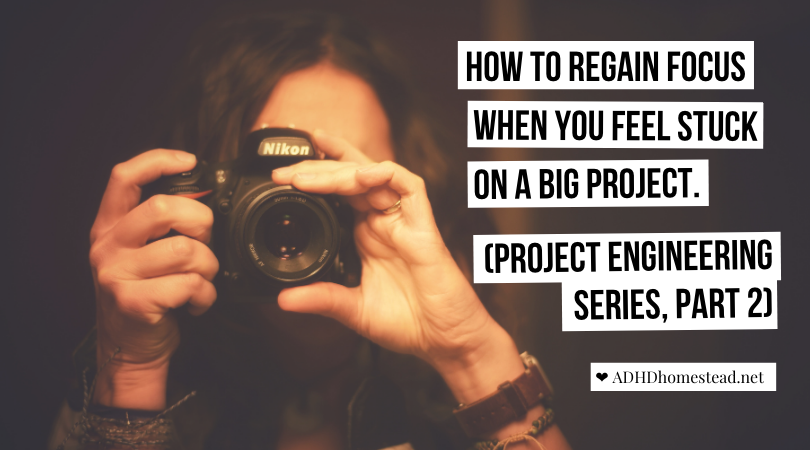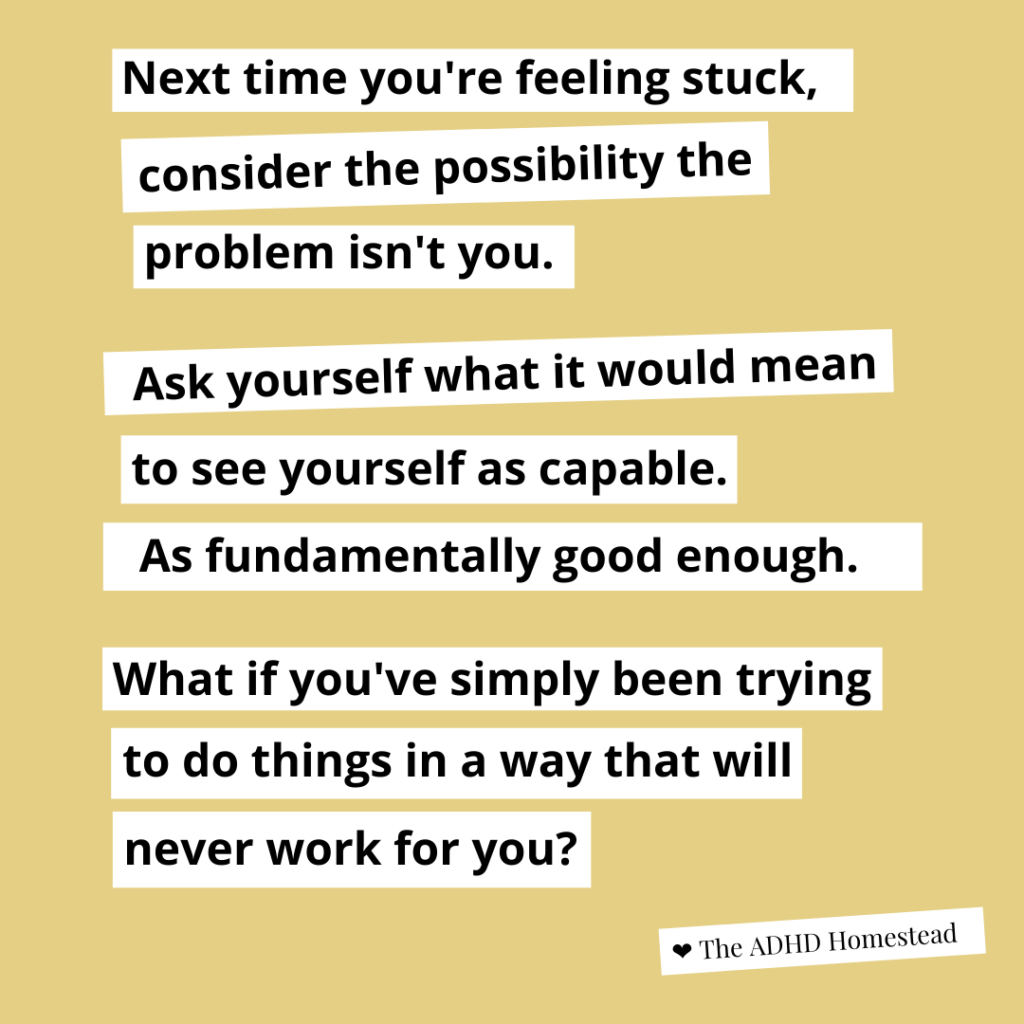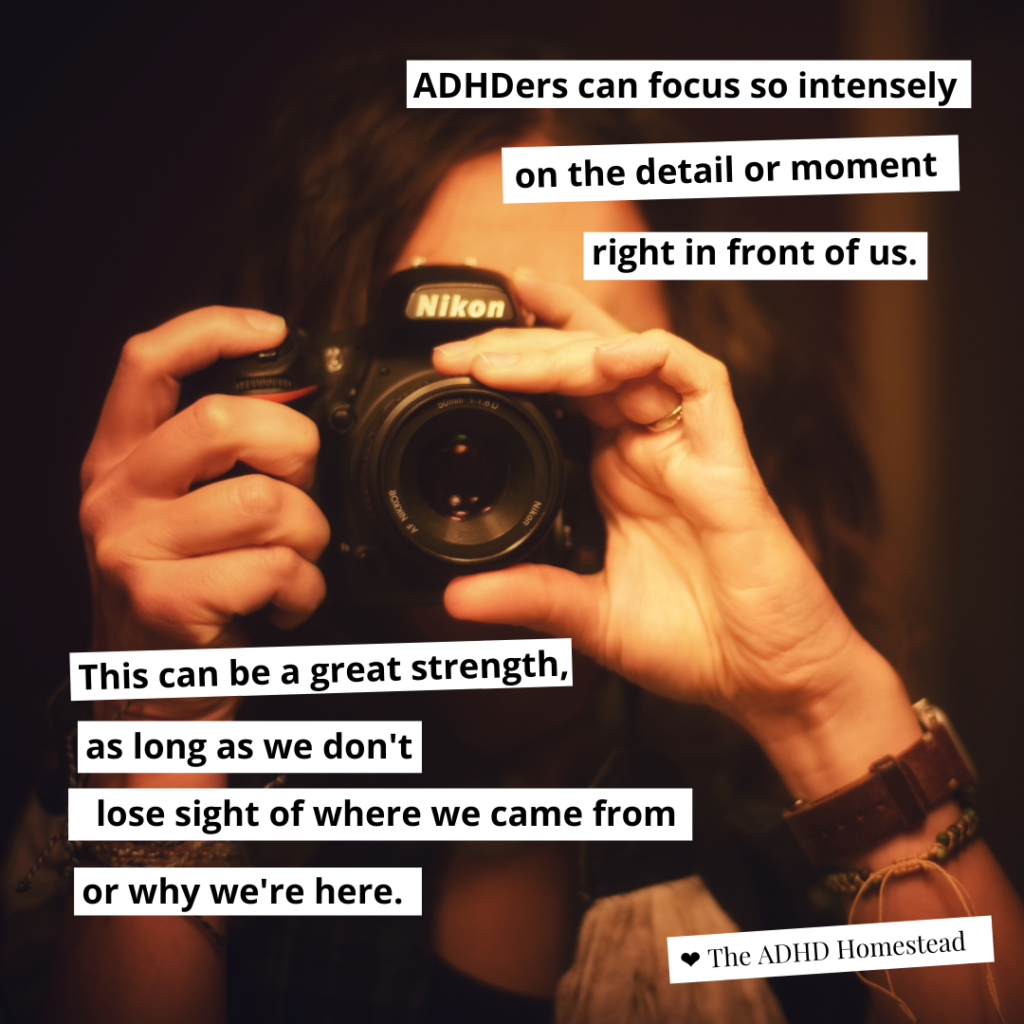If you have ADHD, you’ve probably gotten overwhelmed with a big project before. And someone’s probably offered you the advice, “just break it down into manageable pieces.”
Life skills like this seem to come naturally to most neurotypical folks. It may sound like common sense to us ADHDers too, but the minute we attempt it we realize we have no idea how.
That’s what I want to talk about in this series of posts: how. We all know we need to break projects into manageable pieces. If you read my previous post, you also know this skill is even more important for people with ADHD. Yet for the same reasons we desperately need it, we also have the most trouble actually doing it.
No matter how we break a project down, the first step is identifying — and remembering — what we set out to do in the first place.
Struggle and overwhelm are your cue to pause.
In the last post I talked about my plans to make over my backyard. As my enthusiasm snowballed, my husband voiced concerns about the project being “kind of a lot.” At first I resented his attitude. Of course it was a lot — that was the point!
However, I’ve bitten off more than I could chew in the past1. I’ve learned to pause when people I trust start raising red flags I don’t understand.
Likewise when a project starts to feel too overwhelming, too difficult, or even downright impossible. ADHDers focus intensely on the current moment — not always a bad thing! — and that makes it tough to manipulate all the moving pieces in our heads at once. Our hyperfocusing brains shut out the larger context.
Have you ever stayed locked in a heated argument even though you can’t even remember how it started? That same tendency makes it easier for us to get lost working on a big project. Contrary to what others may tell us, this is not the time to power through or “just do it.” It’s time to pause, remember why we’re here, and make sure we’re still going the right direction.
First question: what are we doing here?
When I get tangled on a project, I stop and return to my original Why. I talk a lot about finding your Why in my book Order from Chaos because ADHDers seldom work for free. We work best when we can draw meaningful connections between the work at hand and our personal identity, values, and desires.
In the case of my backyard, I wanted:
- Productive edible gardens
- Less time spent weeding
- Pretty surroundings for my hammock
- Better environmental stewardship
- Food sourcing
- Pollinator habitat
- Water conservation/runoff prevention
- Less time spent mowing when I rarely use the whole yard
- Hops vines grown separate from the rest of the garden so they stop taking over
- More plants chosen by me, not the previous owner who sold me the house in 2008
- An area of shade to protect me (and maybe some plants!) from the brutal summer sun
There’s a lot of freedom in this list. One action might check several boxes. Another — for example, installing rain barrels — might satisfy only one. This list of desires, my Why, captures the emotions that will motivate me through the work. It doesn’t say anything about how I should accomplish my goals.
The How can be our downfall. When I get stuck or overwhelmed, I’ve usually lost touch with the larger Why and hyperfocused on making a small part of the project work exactly the way I want it to. The first step to getting and keeping a project on track is remembering what brought us here.
Sometimes the way we’re trying to do it just won’t work.
My most recent roadblock in the backyard project illustrates this perfectly. I tried to get fancy with my hammock, which I love and want to feature prominently in the new design. One night, I discovered pergola hammock stands at the bottom of a Pinterest rabbit hole. This felt like a perfect project for the backyard. Not only would the pergola create an impressive focal point in the design, I could use it to trellis my hops vines. The hops vines would then add shade and greenery to my favorite hangout spot.
In other words, I could build something really impressive while satisfying at least four of the eight items on my wish list.
This sounded lovely, but it added a lot of new constraints. I now needed a spot that worked well for the hammock, the pergola, and the vines. I went in circles for days trying to puzzle it out. I cursed my lack of spatial reasoning skills and whined to my husband about how I wasn’t “good enough at this kind of thing” to do something as simple as position a hammock in a yard.
ADHD can trick us into thinking every challenge happens because we are, in some essential way, defective or not enough. That’s not true. Often, things feel hard because we’ve either tried to do the impossible or tried to do things in a way that won’t work for us.
Either way, we need to stop and reassess.
I couldn’t find a good spot for my hammock because it didn’t exist. My backyard simply wouldn’t accommodate my epic, oh-so-clever, and very Pinterest-worthy pergola-trellis-hammock idea.
The Why is more important than the How.
I returned to my original list of desires for the backyard. Could I continue to use my boring black metal hammock stand and still achieve what I wanted? Yes I could. I didn’t need the pergola, and I’d have to let it go.
I won’t downplay how hard that was to swallow. When I get swept up by a big, ambitious idea, my hyperfocus latches on for dear life. Our brains hate few feelings quite so much as breaking our hyperfocus before we’re ready. We fight it hard, and we’ll often lash out at whoever — or whatever — tries to pull us away.
However, I’d hyperfocused on the wrong thing: the How. My fixation with this particular hammock stand overshadowed everything else. Eventually, it felt like the primary problem I needed to solve to make the whole backyard makeover happen.
It wasn’t. The project started with my wish list. That was my Why. And the Why is more important than the How.
If your How won’t get you to your Why, change course.
Most of us live and work with other people and have limited resources to make things happen. I can’t pay a landscape designer and a crew of workers to create my dream backyard in a matter of weeks. I also can’t dig up the entire yard myself and make a colossal mess without ticking off my family, neighbors, and quite possibly some city inspectors. These constraints don’t always play nice with ADHD, but we still need to respect them.
When I get pouty, demoralized, and disappointed about a piece of a project not working, I return to my Why. What did I start this project hoping to achieve? Will changing how I do this part of it keep me from achieving any of that? The answer is usually no.
Constraints also foster creativity. They give us that nudge to pause, think about what’s actually important, and recalculate our route if necessary. Roadblocks — moments of intense overwhelm, disappointment, or outside critique — have a lot to teach us, if we let them. Sometimes they illuminate the best way to get what we want.
Bottom line: we will run into trouble in a big project. We can’t leap into action and disregard all other expectations, responsibilities, and humans in our lives. Having to chart a new course is inevitable. Our Why — the original problem we set out to solve — gives us a lighthouse. No matter how we break down our project, each component can rely on that lighthouse as its destination.
Hey there! Are you enjoying The ADHD Homestead?
Here's the thing: I don't like ads. I don't want to sell your attention to an advertising service run by the world's biggest data mining company. I also value my integrity and my readers' trust above all, which means I accept very few sponsorships/partnerships.
So I'm asking for your support directly. For the cost of one cup of coffee, you can help keep this site unbiased and ad-free.
Below you will find two buttons. The first lets you join our crew of Patreon pals and pledge monthly support for my work. Patrons also have access to my Audioblogs podcast. The second takes you to a simple donation page to pledge one-time or recurring support for The ADHD Homestead, no frills, no strings. Do whichever feels best for you!



